2017 NISSAN SENTRA odometer
[x] Cancel search: odometerPage 303 of 491
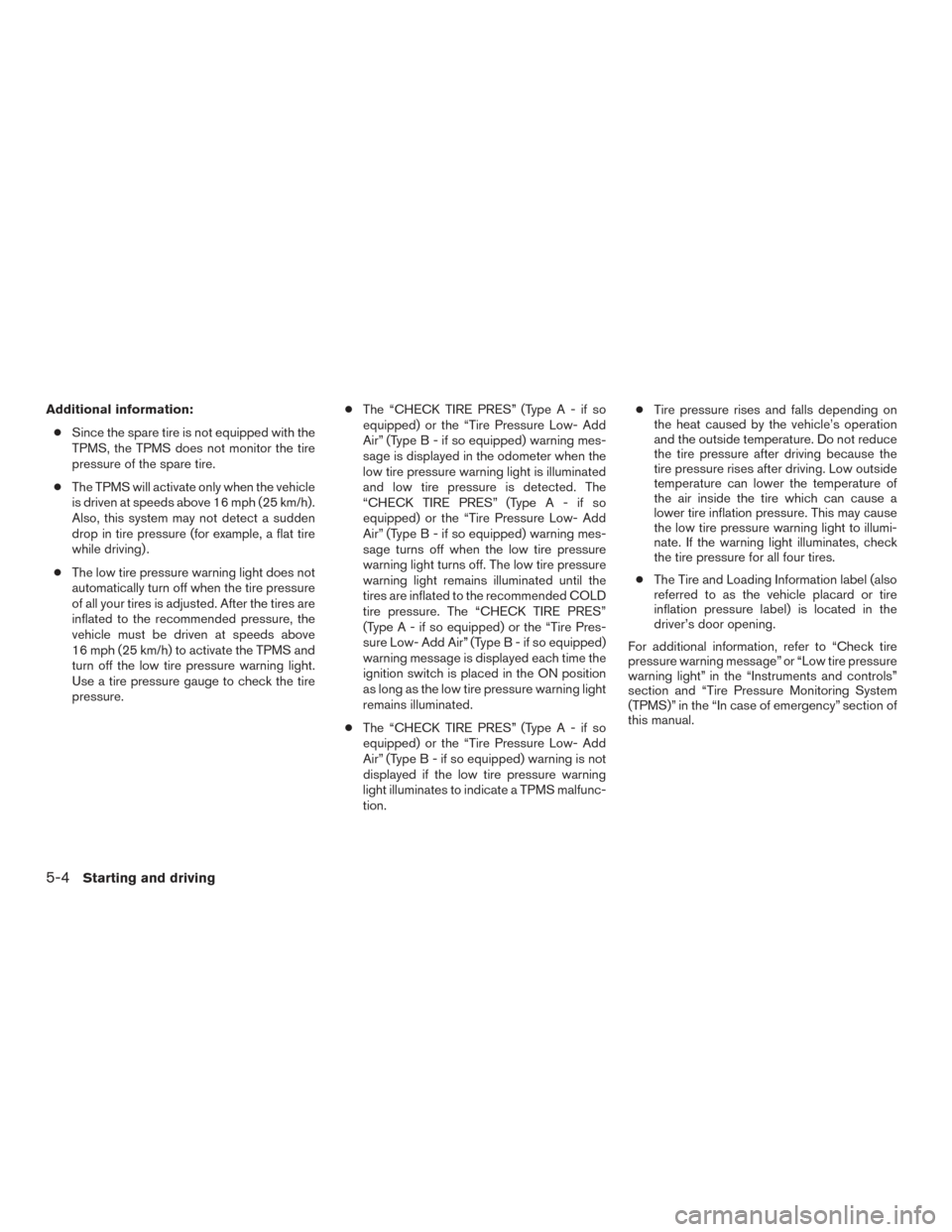
Additional information:● Since the spare tire is not equipped with the
TPMS, the TPMS does not monitor the tire
pressure of the spare tire.
● The TPMS will activate only when the vehicle
is driven at speeds above 16 mph (25 km/h).
Also, this system may not detect a sudden
drop in tire pressure (for example, a flat tire
while driving) .
● The low tire pressure warning light does not
automatically turn off when the tire pressure
of all your tires is adjusted. After the tires are
inflated to the recommended pressure, the
vehicle must be driven at speeds above
16 mph (25 km/h) to activate the TPMS and
turn off the low tire pressure warning light.
Use a tire pressure gauge to check the tire
pressure. ●
The “CHECK TIRE PRES” (TypeA-ifso
equipped) or the “Tire Pressure Low- Add
Air” (TypeB-ifsoequipped) warning mes-
sage is displayed in the odometer when the
low tire pressure warning light is illuminated
and low tire pressure is detected. The
“CHECK TIRE PRES” (TypeA-ifso
equipped) or the “Tire Pressure Low- Add
Air” (TypeB-ifsoequipped) warning mes-
sage turns off when the low tire pressure
warning light turns off. The low tire pressure
warning light remains illuminated until the
tires are inflated to the recommended COLD
tire pressure. The “CHECK TIRE PRES”
(TypeA-ifsoequipped) or the “Tire Pres-
sure Low- Add Air” (TypeB-ifsoequipped)
warning message is displayed each time the
ignition switch is placed in the ON position
as long as the low tire pressure warning light
remains illuminated.
● The “CHECK TIRE PRES” (TypeA-ifso
equipped) or the “Tire Pressure Low- Add
Air” (TypeB-ifsoequipped) warning is not
displayed if the low tire pressure warning
light illuminates to indicate a TPMS malfunc-
tion. ●
Tire pressure rises and falls depending on
the heat caused by the vehicle’s operation
and the outside temperature. Do not reduce
the tire pressure after driving because the
tire pressure rises after driving. Low outside
temperature can lower the temperature of
the air inside the tire which can cause a
lower tire inflation pressure. This may cause
the low tire pressure warning light to illumi-
nate. If the warning light illuminates, check
the tire pressure for all four tires.
● The Tire and Loading Information label (also
referred to as the vehicle placard or tire
inflation pressure label) is located in the
driver’s door opening.
For additional information, refer to “Check tire
pressure warning message” or “Low tire pressure
warning light” in the “Instruments and controls”
section and “Tire Pressure Monitoring System
(TPMS)” in the “In case of emergency” section of
this manual.
5-4Starting and driving
Page 450 of 491
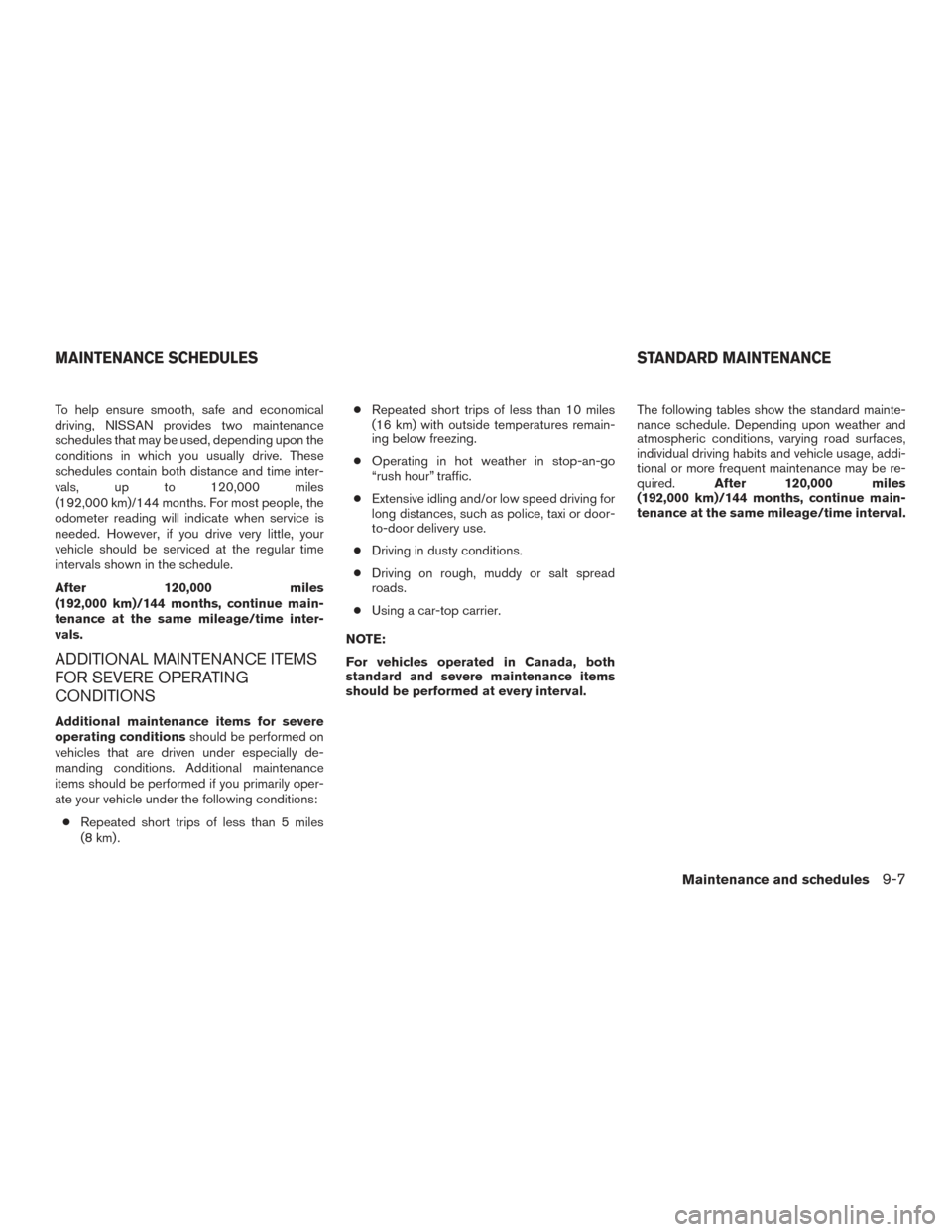
To help ensure smooth, safe and economical
driving, NISSAN provides two maintenance
schedules that may be used, depending upon the
conditions in which you usually drive. These
schedules contain both distance and time inter-
vals, up to 120,000 miles
(192,000 km)/144 months. For most people, the
odometer reading will indicate when service is
needed. However, if you drive very little, your
vehicle should be serviced at the regular time
intervals shown in the schedule.
After 120,000 miles
(192,000 km)/144 months, continue main-
tenance at the same mileage/time inter-
vals.
ADDITIONAL MAINTENANCE ITEMS
FOR SEVERE OPERATING
CONDITIONS
Additional maintenance items for severe
operating conditionsshould be performed on
vehicles that are driven under especially de-
manding conditions. Additional maintenance
items should be performed if you primarily oper-
ate your vehicle under the following conditions:
● Repeated short trips of less than 5 miles
(8 km) . ●
Repeated short trips of less than 10 miles
(16 km) with outside temperatures remain-
ing below freezing.
● Operating in hot weather in stop-an-go
“rush hour” traffic.
● Extensive idling and/or low speed driving for
long distances, such as police, taxi or door-
to-door delivery use.
● Driving in dusty conditions.
● Driving on rough, muddy or salt spread
roads.
● Using a car-top carrier.
NOTE:
For vehicles operated in Canada, both
standard and severe maintenance items
should be performed at every interval. The following tables show the standard mainte-
nance schedule. Depending upon weather and
atmospheric conditions, varying road surfaces,
individual driving habits and vehicle usage, addi-
tional or more frequent maintenance may be re-
quired.
After 120,000 miles
(192,000 km)/144 months, continue main-
tenance at the same mileage/time interval.
MAINTENANCE SCHEDULES STANDARD MAINTENANCE
Maintenance and schedules9-7
Page 484 of 491
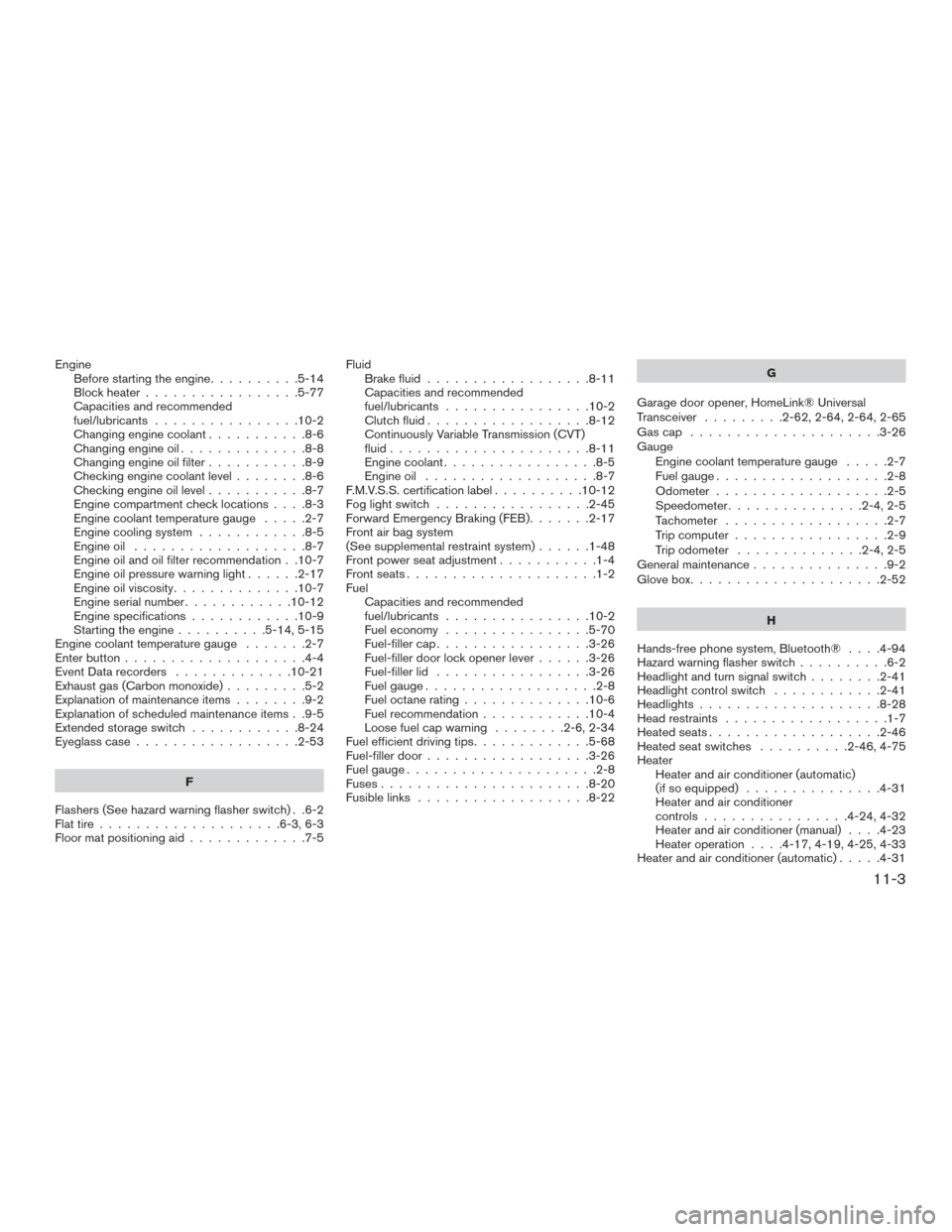
EngineBefore starting the engine ..........5-14
Block heater .................5-77
Capacities and recommended
fuel/lubricants ................10-2
Changing engine coolant ...........8-6
Changing engine oil ..............8-8
Changing engine oil filter ...........8-9
Checking engine coolant level ........8-6
Checking engine oil level ...........8-7
Engine compartment check locations ....8-3
Engine coolant temperature gauge .....2-7
Engine cooling system ............8-5
Engine oil ...................8-7
Engine oil and oil filter recommendation . .10-7
Engine oil pressure warning light ......2-17
Engine oil viscosity ..............10-7
Engine serial number ............10-12
Engine specifications ............10-9
Starting the engine ..........5-14,5-15
Engine coolant temperature gauge .......2-7
Enterbutton....................4-4
Event Data recorders .............10-21
Exhaust gas (Carbon monoxide) .........5-2
Explanation of maintenance items ........9-2
Explanation of scheduled maintenance items . .9-5
Extendedstorageswitch ............8-24
Eyeglass case ..................2-53
F
Flashers (See hazard warning flasher switch) . .6-2
Flat tire ....................6-3,6-3
Floor mat positioning aid .............7-5 Fluid
Brake fluid ..................8-11
Capacities and recommended
fuel/lubricants ................10-2
Clutch fluid ..................8-12
Continuously Variable Transmission (CVT)
fluid......................8-11
Engine coolant .................8-5
Engine oil ...................8-7
F.M.V.S.S. certification label ..........10-12
Foglightswitch .................2-45
Forward Emergency Braking (FEB) .......2-17
Front air bag system
(See supplemental restraint system) ......1-48
Front power seat adjustment ...........1-4
Frontseats.....................1-2
Fuel Capacities and recommended
fuel/lubricants ................10-2
Fuel economy ................5-70
Fuel-filler cap .................3-26
Fuel-filler door lock opener lever ......3-26
Fuel-filler lid .................3-26
Fuel gauge ...................2-8
Fuel octane rating ..............10-6
Fuel recommendation ............10-4
Loose fuel cap warning ........2-6,2-34
Fuel efficient driving tips .............5-68
Fuel-filler door ..................3-26
Fuelgauge.....................2-8
Fuses.......................8-20
Fusiblelinks ...................8-22 G
Garage door opener, HomeLink® Universal
Transceiver .........2-62,2-64,2-64,2-65
Gascap .....................3-26
Gauge Engine coolant temperature gauge .....2-7
Fuelgauge...................2-8
Odometer ...................
2-5
Speedometer ...............2-4,2-5
Tachometer ..................2-7
Trip computer .................2-9
Trip odometer ..............2-4,2-5
General maintenance ...............9-2
Glovebox.....................2-52
H
Hands-free phone system, Bluetooth® ....4-94
Hazard warning flasher switch ..........6-2
Headlightandturnsignalswitch........2-41
Headlightcontrolswitch ............2-41
Headlights....................8-28
Head restraints ..................1-7
Heated seats ...................2-46
Heated seat switches ..........2-46,4-75
Heater Heater and air conditioner (automatic)
(if so equipped) ...............4-31
Heater and air conditioner
controls ................4-24,4-32
Heater and air conditioner (manual) ....4-23
Heater operation ....4-17,4-19,4-25,4-33
Heater and air conditioner (automatic) .....4-31
11-3
Page 486 of 491
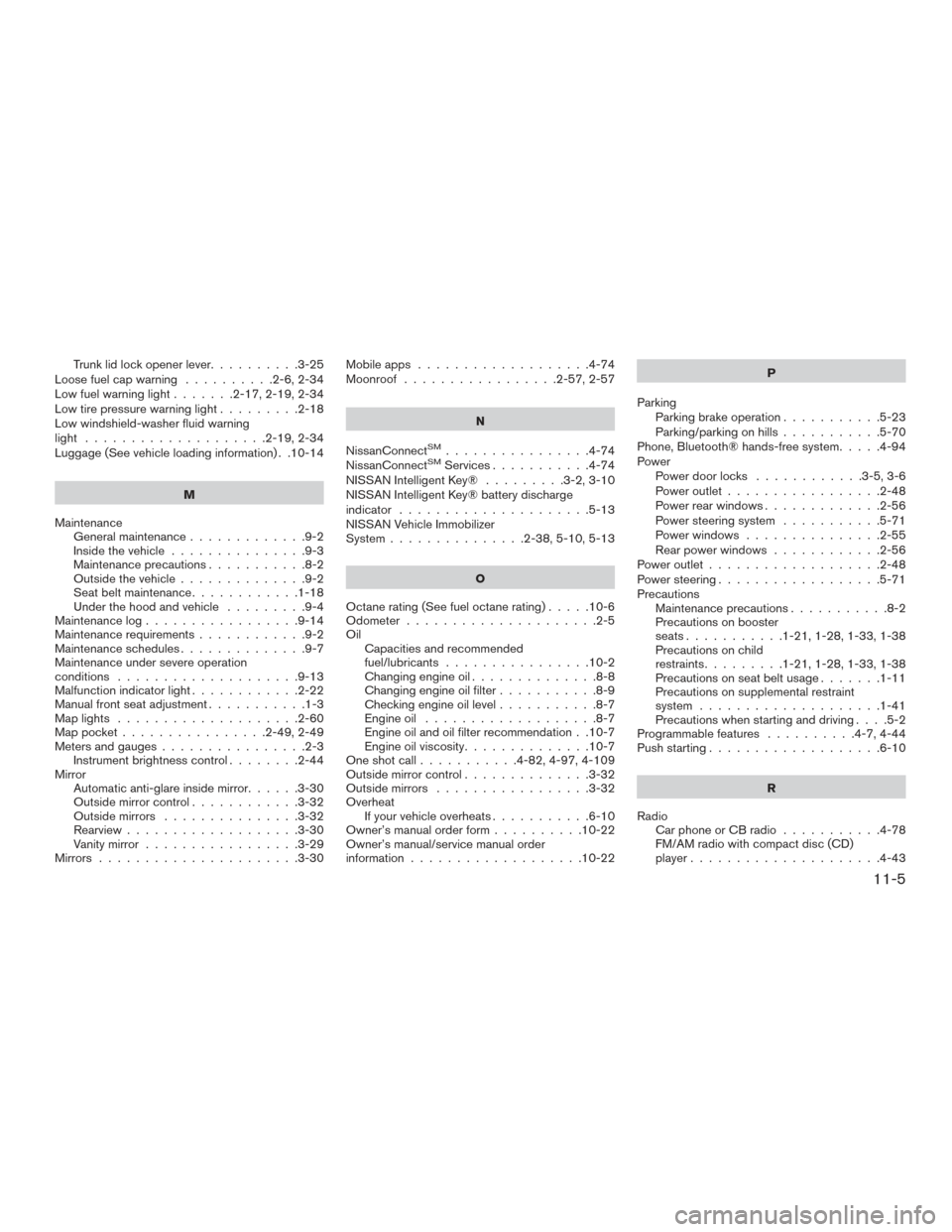
Trunk lid lock opener lever..........3-25
Loose fuel cap warning ..........2-6,2-34
Lowfuelwarninglight.......2-17,2-19,2-34
Low tire pressure warning light .........2-18
Low windshield-washer fluid warning
light ....................2-19,2-34
Luggage (See vehicle loading information) . .10-14
M
Maintenance General maintenance .............9-2
Insidethevehicle...............9-3
Maintenance precautions ...........8-2
Outside the vehicle ..............9-2
Seat belt maintenance ............1-18
Under the hood and vehicle .........9-4
Maintenance log .................9-14
Maintenance requirements ............9-2
Maintenance schedules ..............9-7
Maintenance under severe operation
conditions ....................9-13
Malfunction indicator light ............2-22
Manual front seat adjustment ...........1-3
Maplights ....................2-60
Map pocket ................2-49,2-49
Meters and gauges ................2-3
Instrument brightness control ........2-44
Mirror Automatic anti-glare inside mirror ......3-30
Outside mirror control ............3-32
Outside mirrors ...............3-32
Rearview ...................3-30
Vanity mirror .................3-29
Mirrors ......................3-30 Mobileapps ...................4-74
Moonroof
.................2-57,2-57
N
NissanConnect
SM................4-74
NissanConnectSMServices...........4-74
NISSAN Intelligent Key® .........3-2,3-10
NISSAN Intelligent Key® battery discharge
indicator .....................5-13
NISSAN Vehicle Immobilizer
System ...............2-38,5-10,5-13
O
Octane rating (See fuel octane rating) .....10-6
Odometer .....................2-5
Oil Capacities and recommended
fuel/lubricants ................10-2
Changingengineoil..............8-8
Changing engine oil filter ...........8-9
Checking engine oil level ...........8-7
Engine oil ...................8-7
Engine oil and oil filter recommendation . .10-7
Engine oil viscosity ..............10-7
Oneshotcall...........4-82,4-97,4-109
Outside mirror control ..............3-32
Outside mirrors .................3-32
Overheat If your vehicle overheats ...........6-10
Owner’s manual order form ..........10-22
Owner’s manual/service manual order
information ...................10-22 P
Parking Parking brake operation ...........5-23
Parking/parking on hills ...........5-70
Phone, Bluetooth® hands-free system .....4-94
Power Powerdoorlocks ............3-5,3-6
Power outlet .................2-48
Power rear windows .............2-56
Power steering system ...........5-71
Power windows ...............2-55
Rear power windows ............2-56
Power outlet ...................2-48
Power steering ..................5-71
Precautions Maintenance precautions ...........8-2
Precautions on booster
seats ...........1-21,1-28,1-33,1-38
Precautions on child
restraints .........1-21,1-28,1-33,1-38
Precautions on seat belt usage .......1-11
Precautions on supplemental restraint
system ....................1-41
Precautions when starting and driving ....5-2
Programmable features ..........4-7,4-44
Push starting ...................6-10
R
Radio CarphoneorCBradio ...........4-78
FM/AM radio with compact disc (CD)
player .....................4-43
11-5
Page 488 of 491
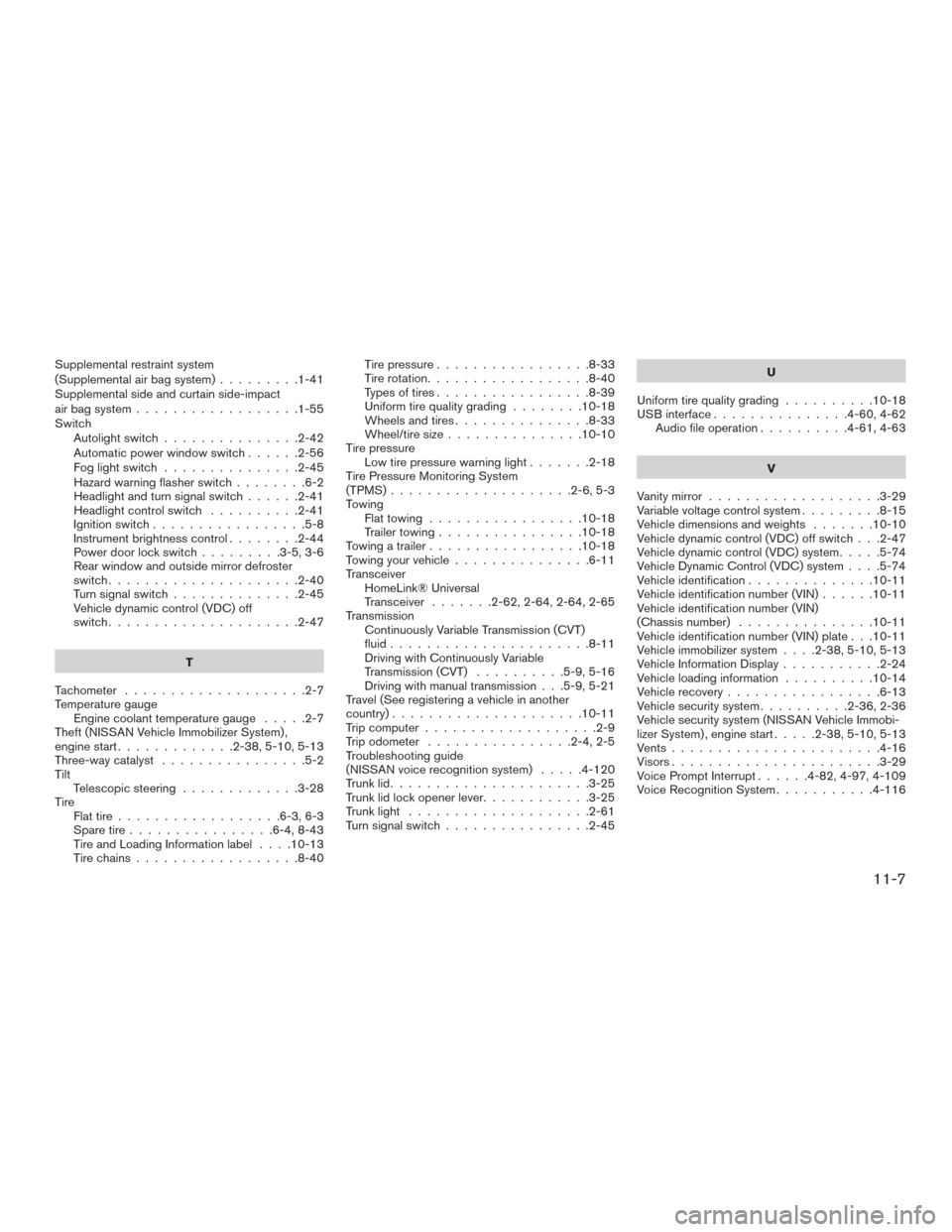
Supplemental restraint system
(Supplemental air bag system).........1-41
Supplemental side and curtain side-impact
air bag system ..................1-55
Switch Autolightswitch...............2-42
Automatic power window switch ......2-56
Foglightswitch ...............2-45
Hazard warning flasher switch ........6-2
Headlight and turn signal switch ......2-41
Headlight control switch ..........2-41
Ignition switch .................5-8
Instrument brightness control ........2-44
Power door lock switch .........3-5,3-6
Rear window and outside mirror defroster
switch.....................2-40
Turnsignalswitch..............2-45
Vehicle dynamic control (VDC) off
switch.....................2-47
T
Tachometer ....................2-7
Temperature gauge Engine coolant temperature gauge .....2-7
Theft (NISSAN Vehicle Immobilizer System) ,
engine start .............2-38,5-10,5-13
Three-way catalyst ................5-2
Tilt Telescopic steering .............3-28
Tire Flat tire ..................6-3,6-3
Spare tire ................6-4,8-43
TireandLoadingInformationlabel ....10-13
Tire chains ..................8-40 Tirepressure.................8-33
Tire rotation..................8-40
Types of tires
.................8-39
Uniform tire quality grading ........10-18
Wheels and tires ...............8-33
Wheel/tire size ...............10-10
Tire pressure Low tire pressure warning light .......2-18
Tire Pressure Monitoring System
(TPMS) ....................2-6,5-3
Towing Flattowing.................10-18
Trailer towing ................10-18
Towing a trailer .................10-18
Towingyourvehicle...............6-11
Transceiver HomeLink® Universal
Transceiver .......2-62,2-64,2-64,2-65
Transmission Continuously Variable Transmission (CVT)
fluid......................8-11
Driving with Continuously Variable
Transmission (CVT) ..........5-9,5-16
Driving with manual transmission . . .5-9, 5-21
Travel (See registering a vehicle in another
country) .....................10-11
Trip computer ...................2-9
Trip odometer ................2-4,2-5
Troubleshooting guide
(NISSAN voice recognition system) .....4-120
Trunklid......................3-25
Trunklidlockopenerlever............3-25
Trunklight ....................2-61
Turn signal switch ................2-45 U
Uniform tire quality grading ..........10-18
USB interface ...............4-60,4-62
Audio file operation ..........4-61,4-63
V
Vanity mirror ...................3-29
Variable voltage control system .........8-15
Vehicle dimensions and weights .......10-10
Vehicle dynamic control (VDC) off switch . . .2-47
Vehicle dynamic control (VDC) system .....5-74
Vehicle Dynamic Control (VDC) system . . . .5-74
Vehicle identification ..............10-11
Vehicle identification number (VIN) ......10-11
V
ehicle identification number (VIN)
(Chassis number) ...............10-11
Vehicle identification number (VIN) plate . . .10-11
Vehicle immobilizer system ....2-38,5-10,5-13
Vehicle Information Display ...........2-24
Vehicle loading information ..........10-14
Vehicle recovery .................6-13
Vehicle security system ..........2-36,2-36
Vehicle security system (NISSAN Vehicle Immobi-
lizer System) , engine start .....2-38,5-10,5-13
Vents.......................4-16
Visors.......................3-29
Voice Prompt Interrupt ......4-82,4-97,4-109
Voice Recognition System ...........4-116
11-7